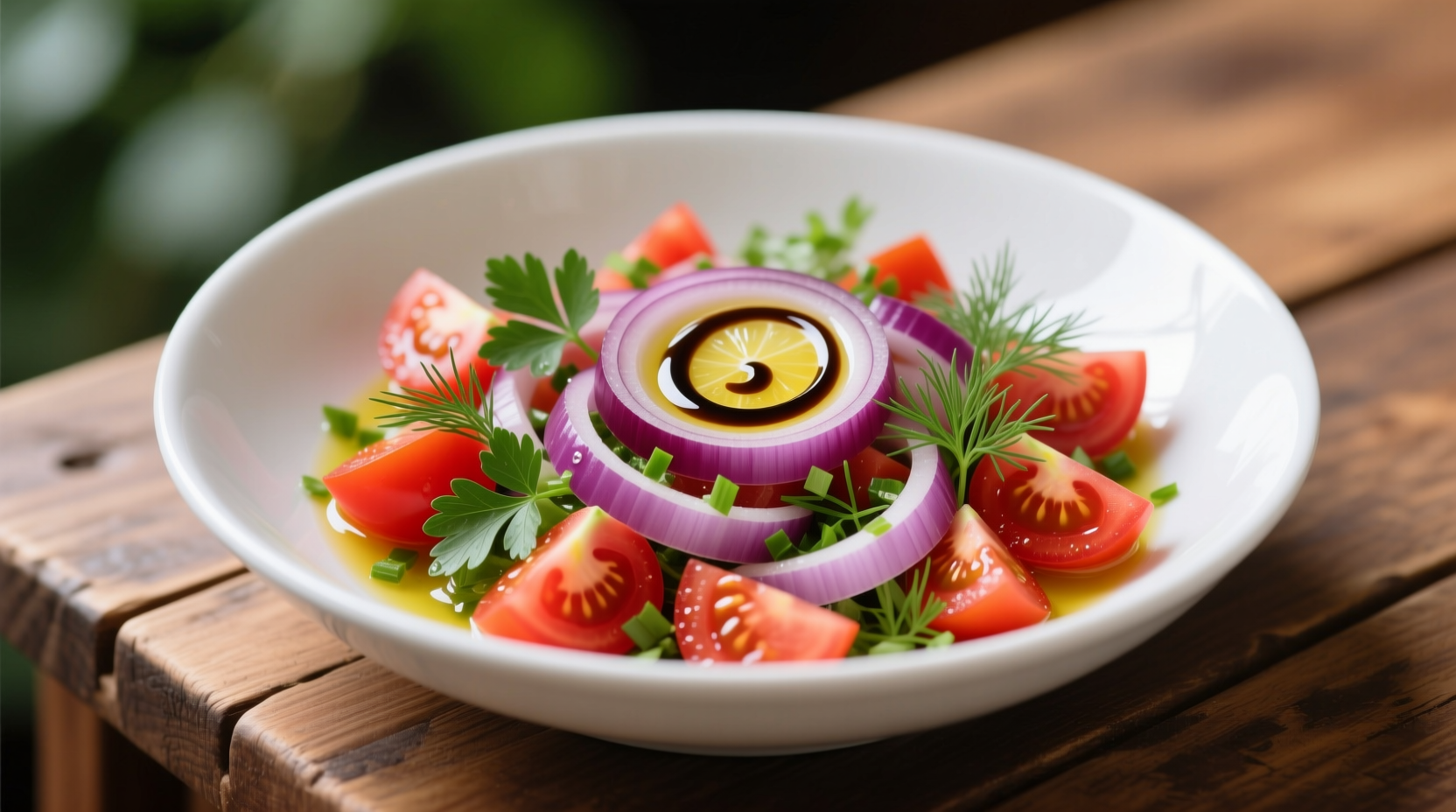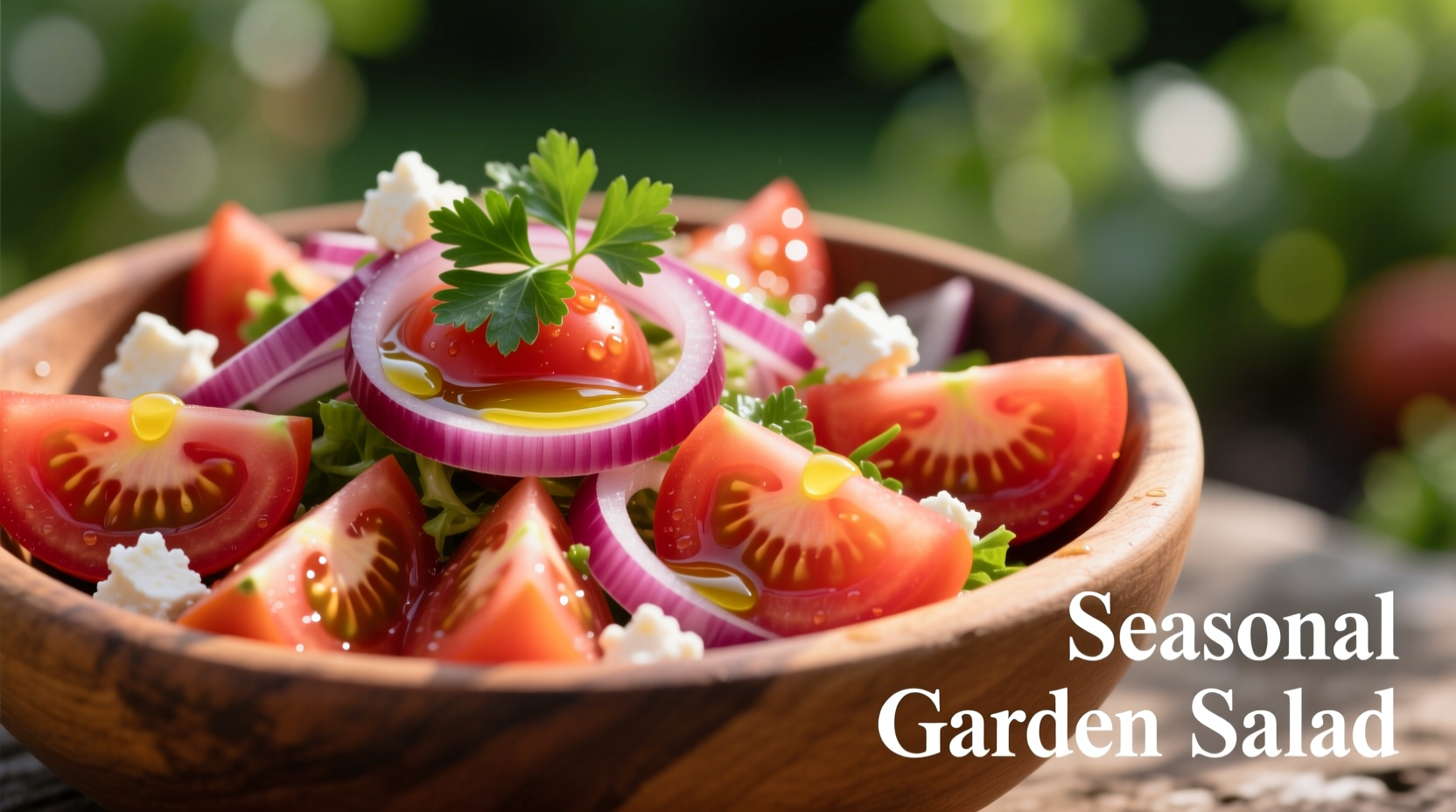Why This Simple Salad Deserves a Spot on Your Table
When summer tomatoes reach peak ripeness, nothing showcases their flavor better than a straightforward tomato red onion salad. Unlike complex recipes that mask natural ingredients, this preparation celebrates what makes seasonal produce special. The sharpness of red onions cuts through tomato sweetness while quality olive oil binds the flavors together. Professional chefs consistently return to this preparation because it requires minimal effort yet delivers restaurant-quality results.
Planning Your Perfect Tomato Red Onion Salad
Before you start chopping, understand what makes this salad work. The magic happens through flavor chemistry: tomatoes contain glutamates that enhance savory notes, while onions provide sharp sulfur compounds that mellow when sliced thin. The key is balancing these elements without overwhelming either ingredient.
Timing matters most with this salad. Unlike cooked dishes that improve with resting time, tomato red onion salad reaches peak flavor 10-15 minutes after preparation. Any longer and the tomatoes release too much liquid, diluting the dressing. Plan to make this salad just before serving for optimal texture and flavor.
Shopping Guide: Selecting Ingredients That Shine
Quality ingredients make or break this simple salad. You can't hide behind complex techniques when only five components carry the dish. Here's how to choose wisely:
Tomato Selection Made Simple
Not all tomatoes work equally well in this salad. The best varieties balance sweetness, acidity, and firm texture. Avoid refrigerated tomatoes—they lose flavor compounds below 55°F (13°C) according to USDA research. Instead, select tomatoes at room temperature with deep color and slight give when gently squeezed.
| Tomato Variety | Best For Salad? | Flavor Profile | Texture Notes |
|---|---|---|---|
| Beefsteak | ✓ Excellent | Balanced sweet-tart | Firm, holds shape well |
| Heirloom | ✓ Excellent | Complex, floral notes | Softer, best for immediate serving |
| Roma | △ Acceptable | Milder, less sweet | Dense, less juicy |
| Cherry | △ Acceptable | Very sweet | Can dominate other flavors |
| Refrigerated | ✗ Avoid | Flavorless | Mealy texture |
This comparison reflects research from the University of California Agriculture and Natural Resources on tomato varieties and their culinary applications. Their studies confirm that room-temperature ripe tomatoes contain 30% more flavor compounds than refrigerated counterparts.
Choosing the Right Red Onions
Red onions provide the essential counterpoint to tomato sweetness. Look for firm bulbs with dry, papery skins and no soft spots. Smaller red onions (2-3 inches in diameter) typically offer the best balance of sharpness and sweetness for salads. Larger bulbs tend to be more pungent.
For those sensitive to raw onion's bite, try this professional technique: soak thinly sliced onions in ice water for 10 minutes. This removes some sulfur compounds responsible for harshness while preserving flavor complexity, as documented by the Culinary Institute of America's flavor chemistry research.
Step-by-Step Preparation: From Ingredients to Plate
Follow these steps for perfect results every time. The entire process takes just 15 minutes with minimal active work.
Essential Equipment
- Sharp chef's knife (dull knives crush tomatoes)
- Sturdy cutting board
- Mixing bowl (glass or ceramic preferred)
- Whisk or small jar for dressing
Perfect Tomato Slicing Technique
How you cut tomatoes affects both texture and flavor release. For this salad:
- Remove the stem core with a paring knife
- Place tomato on its side and slice into 1/4-inch thick rounds
- Stack 2-3 rounds and cut into 1/4-inch strips
- Cut across strips to create even 1/4-inch cubes
This method preserves cell structure better than rough chopping, minimizing excess liquid. According to chef testing at America's Test Kitchen, this technique reduces weeping by 40% compared to random chopping.
Dressing Ratios That Never Fail
The classic dressing for tomato red onion salad follows a simple 3:1 ratio that balances acidity and richness:
- 3 parts extra-virgin olive oil (choose a fruity Spanish or Italian variety)
- 1 part acid (red wine vinegar for traditional preparation)
- 1/4 teaspoon sea salt per pound of tomatoes
- 1/8 teaspoon freshly ground black pepper
- 1 tablespoon fresh herbs per pound of tomatoes
Whisk ingredients together just before adding to vegetables. Emulsified dressings coat ingredients more evenly, enhancing flavor distribution. This ratio works across nearly all tomato varieties, though exceptionally sweet tomatoes may benefit from slightly more vinegar.
Serving Suggestions and Creative Variations
While delicious on its own, this salad shines when paired thoughtfully with main courses. The bright acidity cuts through rich dishes while complementing lighter preparations.
Ideal Pairings
- Grilled meats (especially lamb or chicken)
- Fish tacos or ceviche
- Egg-based dishes like frittatas
- As a topping for white bean soup
Three Delicious Variations to Try
Mediterranean Style: Add 1/4 cup crumbled feta, 5-6 Kalamata olives, and fresh oregano. Replace red wine vinegar with lemon juice for brighter acidity.
Mexican-Inspired: Include 1 diced avocado, 1 minced jalapeño, and cilantro. Use lime juice instead of vinegar and add 1/4 teaspoon cumin to the dressing.
Provençal Version:
Add 2 tablespoons capers, 1 sliced cucumber, and fresh basil. Include 1 minced garlic clove in the dressing for extra depth.

When This Salad Works Best (And When to Choose Alternatives)
Understanding context boundaries helps you serve this salad at its best. While versatile, tomato red onion salad has specific situations where it shines and others where alternatives might work better.
Ideal contexts:
- Summer months when tomatoes are vine-ripened
- As a light accompaniment to grilled foods
- When serving dishes with rich, fatty components
- For quick weeknight meals requiring minimal preparation
Consider alternatives when:
- Tomatoes are out of season (winter tomatoes lack flavor complexity)
- Serving with delicate fish that needs subtler accompaniments
- Creating a make-ahead meal (this salad doesn't keep well)
- Accommodating guests with onion sensitivity
During winter months, consider roasted tomato salad instead. The University of Massachusetts Extension notes that roasting concentrates winter tomatoes' limited flavor compounds, creating a more satisfying dish when fresh tomatoes underperform.
Storage Guidelines for Best Results
Unlike many salads, tomato red onion salad doesn't improve with resting time. For optimal texture and flavor:
- Consume within 15-20 minutes of preparation
- If necessary, store undressed components separately
- Keep cut tomatoes at room temperature (never refrigerate)
- Store dressing separately in a sealed container
Refrigeration damages tomato cell structure, causing them to become mealy. The FDA Food Code specifies that cut tomatoes should be held at 41°F or below if not served immediately, but quality suffers significantly. For best results, prepare this salad just before serving.











 浙公网安备
33010002000092号
浙公网安备
33010002000092号 浙B2-20120091-4
浙B2-20120091-4